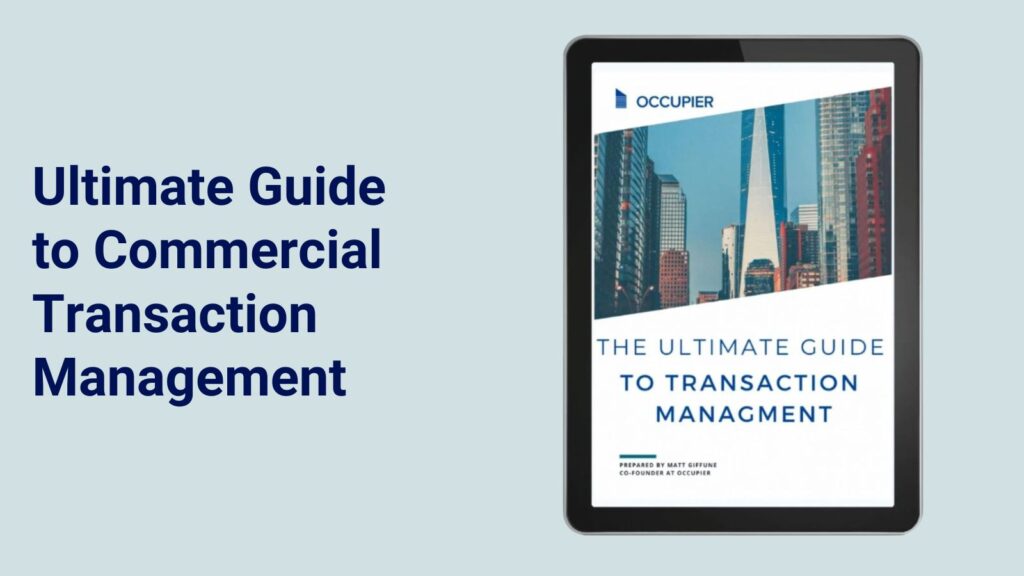The Benefits of Commercial Transaction Management Software
Last Updated on May 11, 2023 by Morgan Beard
The commercial real estate industry’s shift to digital is well underway. Transaction management software has become a large part of the technological disruption. Commercial transaction management, marks the initial phase of the lease lifecycle. It guides a team from strategic planning to site selection and negotiations.
Commercial Transaction Management Software Explained
Real estate transaction management software simplifies the operational process by centralizing transactions through a single dashboard, enabling more thorough data analysis and allowing for collaboration among stakeholders — including tenants and tenant-rep brokers. And with the speed at which the market moves only picking up pace, relying on more “traditional” tools no longer makes good business sense.
This isn’t to say the likes of Excel or Google Docs don’t have a place in modern operations, but there are risks associated with their exclusive use. For one, it can lead to stale and siloed data. Once that happens, your real estate deals can slide, task delineation can become muddy, and growth can slow and stagnate altogether. Then, there’s the complicated matter of reporting, a critical component of real estate management. Manual processes are prone to delays, if not inaccuracies. Besides, real estate teams must deal with several issues at once. Traditional tools still make the tasks time-consuming. When all combined, it just decreases the chances of securing more favorable lease options for any given space.
By centralizing their lease deal pipelines, real estate teams can be more strategic and prescriptive in their negotiations. From fixed financials and operating expenses to space planning and market comps, there are many data points behind every potential deal. It can be of benefit to aggregate information into a single source of truth, where all stakeholders can strategically approach which lease deals to move forward and which to disqualify. Even when it doesn’t entail a critical decision, commercial real estate transaction software can serve as a foundation for a more centralized organization. It then becomes much easier to focus everyone on a distinct vision, standardize processes and procedures, and build workflows that keep employees moving in the same direction.
The Impact of Automated Transaction Management
Automating almost any process adds speed and efficiency to operations. Real estate transaction management software is no different. It relieves team members of repetitive tasks, freeing up time to focus on more value-added activities. But the impact of such a solution goes deeper than mere automation, allowing you to:
1. Strategize growth goals.
Tracking the deal pipeline stages in real estate transaction software is often the first step to understanding how long it takes to bring a deal across the finish line. So, if you have an annual growth goal of 15 new leased locations, and you know that it takes eight months to reach a letter of intent (or LOI), and 20% of those LOIs convert to executed deals, then you can estimate how many LOIs you’ll need during a particular timeframe.
2. Negotiate from an informed position.
Commercial landlords hold all the cards in a hot real estate market. During times of economic uncertainty, however, tenants can negotiate more favorable lease terms as landlords look to fill their vacancies. Real estate transaction software centralizes all the necessary information, allowing you to negotiate from an informed position and adding much-needed speed to the decision-making process.
3. Facilitate faster deal cycles.
Time is money, as they say. Real estate transaction software provides a real-time pulse of how long a potential deal will take to execute. With that knowledge in mind, you’re better prepared to look for deal stages that can be accelerated. More importantly, you can search for particular data points to mark as red flags or green lights throughout the entire deal process.
Transaction management is key to driving commercial real estate growth! Historically, commercial tenants and their tenant-rep brokers track commercial real estate deals in an Excel spreadsheet. Download our ultimate guide to transaction management and take a peek at how digitize your deal pipeline and accelerate your expansion growth goals.
Too much depends on your company’s real estate portfolio to leave it in the hands of traditional tools and manual processes. Real estate transaction management software brings the back and front offices together, as well as other stakeholders, allowing the entire organization to improve the quality of their work, understand the market, and operate from a more informed position. Few questions remain about a given property, strengthening all the moving parts of your operations. Not only can this help you better utilize your resources, but it also saves time and money in the process. In the end, however, you’ll likely find yourself with more favorable contractual lease obligations — and isn’t that what it’s really all about?
Real estate transaction management doesn’t need to be a complicated undertaking. It all comes down to the solution you use. If you want to learn more about the process or would like additional information on transaction management, please feel free to schedule a demo.

